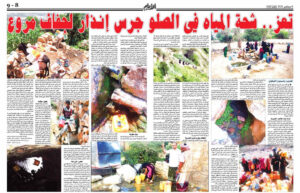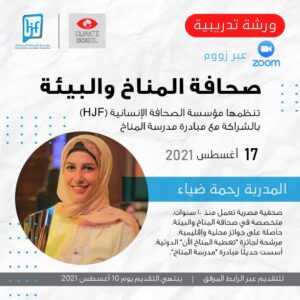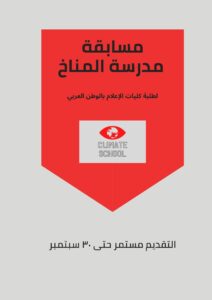Report: Yasmine Al-Salawi
“In most of the district’s villages, people compete for water, which leads to severe conflicts that reach the point of using violence in order to obtain water. Years ago, a quarrel occurred between some individuals at a spring in the back of the mountain, over a gallon of water, which led to them falling from the vicinity of the spring. To the suburb and their death, says Widad Al-Salawi, a health activist in the district.
Among the thousands of girls who face the problem of fetching water from far away areas, especially in the winter season when there is little rain, she adds, “Some families have deprived their daughters of education in order to save water, not to mention the health damage that may affect their health in the future, as a result of pregnancy.” A large amount of water on their heads from long distances.
A water crisis besieges the district
Only the lights of the kerosene lamps that villagers carry in the reefs, valleys, and villages of the Al-Silw District, searching for water in the dark hours of the night, are sufficient to convey the extent of the suffering that residents endure as a result of water scarcity.
Residents of Al-Silw District are complaining of a stifling water crisis, especially in recent years when the rain that feeds underground wells and springs in general has decreased, which has led to a decline in their water springs and the depletion of some of them, which portends the occurrence of an unprecedented drought in the District, especially since water Groundwater and springs are the population's only source of water.
Nabila Abdel Hafeez (33 years old), despite the passage of three years, still remembers the suffering of her family, who were displaced from the city of Hodeidah when battles erupted on the outskirts of the city in 2018, to their home in one of the villages of the Al-Salu District. She says, “We returned to Hodeidah despite the continued The war, after we saw it, is less severe than the war to obtain water and die of thirst.
The water level of the wells and springs decreased, which prompted residents to leave their homes and their animals in the late hours of the night, to those wells and springs in the mountains and for medicines before the sun rose, and residents of villages in nearby districts that suffer from the same problem flock to them.
The return of many citizens to the district from cities as a result of wars and the increase in population density contributed to the expansion of citizens’ need for water, which prompted many to randomly dig their own wells, which led to the depletion of wells that are the only outlet for more than one village.
The village of Habak is one of the villages whose residents suffer from water scarcity, as there is a small spring in the village that feeds five villages: “Habak,” “Al-Maqtar,” “Haid Al-Turk,” “Al-Salal,” and “Al-Nakab.”
“My son goes out in the morning and comes back at 12 noon. All he can get is 4 gallons of 15 liters of water. This is how Aed Al-Salawi, a citizen of the village, begins his speech. He pointed out in his speech that citizens struggle in front of this small spring in order to obtain water, especially in the winter, as they come from their villages in the late hours of the night to fetch water with their animals and on the heads of women and children.
Ayed Al-Salawi confirms in his speech that the crowding of citizens in front of this spring always leads to the outbreak of problems that end with the allocation of specific hours during which each village is allowed to take its share of water.
The village of Habak is not the only one to which many residents of distant villages flock for the sake of this small eye. In Al-Sa’ila (Sa’ila Al-Hadiya), which separates the two districts, “Quds” and “Al-Sulu,” there is a well that feeds more than 6 villages, including “Al-Shu’bah,” “Al-Hadiya,” “Al-Ma’amra,” “Al-Jabbana,” “Al-Nakab,” and others, which are villages distributed between the two districts.
As you overlook this valley, you see these plastic gallons of different colors crowding on the backs of donkeys and in the hands of women descending from the mountains and villages to the tank that is being filled from the well. You are afraid for the future of this district, whose residents may be killed by thirst if agencies and organizations do not provide quick solutions to save it from drought.
Citizens told the report’s author that in the winter, had it not been for this well, they would have been completely unable to obtain water.
Abdul Jalil Gharsan, Director of Al-Silw District, says that the district suffers from water scarcity because it is located on a mountain range, especially since water on the slopes of the mountains is scarce, in addition to the fact that the district lacks water sources such as rivers and other sources.
Gharsan confirms that people's suffering has worsened in recent years due to the scarcity of rain, in addition to the significant increase in population density in the district.
Gharsan adds, “The directorate suffers from neglect by previous governments and the lack of social figures in the directorate whose concern is the citizen’s interest, as they were able to convey people’s suffering in order to obtain water projects for the directorate like any other directorate in the republic. Therefore, the directorate remained in constant deprivation, not in water.” Just; But in all necessary services.
Drought invades the villages of the district
Al-Silw District is located in the southeast of Taiz Governorate, about 45 kilometers away from the city. It consists of 11 districts and 56 villages, with a population of 49,802 people, according to the latest population survey of the district.
Al-Salu District has been suffering from the deterioration of basic services for a long time, and this suffering has worsened since the outbreak of war in the district in 2016 between the Ansar Allah group (Houthis) and the forces loyal to the internationally recognized government, which lasted for two years. The citizen there resists the tragic situation and bitter living conditions, clinging to survival, hoping that... What comes next holds something beautiful for the people of the forgotten district, despite its importance and history.
The Al-Mashjab district is one of the districts most affected by water scarcity, as residents suffer from a lack of clean water, which forces residents to search for water from nearby districts. Walid Shamsan, a resident of Al-Azala, says that most of the villages in Al-Azala do not have wells, so the people of this village travel long distances. To the districts of Haifan and Khadir, adjacent to Al-Silw district, to get a little water.
“Some families, who are very few, can afford the value of a liter of water, and those who can pay the amount find it difficult to reach them due to the rugged road,” he added.
The situation is similar to the villages of Upper Egypt, Al-Qibla, Hamda, and Al-Qibla, which do not have wells, so their residents rely on rainwater that collects in ground tanks, forcing them to travel long distances to fetch water from neighboring villages and districts.
The isolation of Al-Mashjab is not the only one whose residents are suffering this suffering. There are many villages and isolation areas in Al-Salu District. The depletion of its wells and springs has forced its women and children to climb dangerous roads in the mountains and terraces, heading to neighboring villages and districts to fill water.
Citizens in the district say that they were forced to sell their livestock for fear of dying of thirst, as the water they get, especially in the winter, can hardly satisfy their needs.
Regarding the role of the local authority, Abdul Jalil Gharsan says that the local authority, under the current circumstances, could not meet the water needs of citizens, and the reason is the lack of a budget for development work.
He added: “We have partnered with humanitarian organizations to provide some water sources and build individual and collective tanks, but this remains a temporary patchwork solution that does not meet the citizen’s need for water permanently.”
Polluted water
Asmaa (30 years old) goes out every day in the early morning and takes about a quarter of an hour to walk until she reaches the well from which she fetches water. She says that in many cases she arrives when the well’s water has dried up, due to the fact that many people flock to it until the late hours of the night. .
Asmaa is one of the women in the villages of Al-Salu District, who performs the same tasks on a daily basis in order to search for drinking water. She says that she, her sisters, and women from the village sit for long hours next to the well, waiting for the water to collect.
She adds, “Because the water is scooped up from the well, we get water full of impurities, such as dust and gravel. Although this well is exposed, we find no other alternative to obtain water.”
Samia believes that there are pools from which dogs and livestock drink, and they are exposed to dust and weather fluctuations, not to mention the way citizens scoop water with unclean containers. Regarding open wells, Samia says that in some wells they find dead animals and insects.
This was confirmed by Dr. Walid Shamsan, an activist from the district, that the scarcity of water in the district forced people to resort to unclean sources to obtain drinking water.
Walid points out in his speech by saying, “It is known that many rural residents defecate in the open, and when the rains come, this feces are washed away from the reefs, mountains, and slopes into some wells, as happened in Wadi Jahafi, which led to the spread of the cholera epidemic in the villages and the isolation of the district.”
In turn, Abdul Jalil Gharsan says that due to the scarcity of water, residents of the district have resorted to collecting rainwater from the roofs of their homes in portable tanks or building cement tanks next to their homes, which are filled with rainwater during the rainy seasons, which is always polluted due to roof dust.
Agriculture is damaged
Al-Silw District is known to be one of the areas famous for growing many fruits and vegetables, including guava, pomegranates, grapes, and bananas, and vegetables include leeks, radishes, and coriander, especially since Al-Silw is the true home of onions and wild cardamom. However, the production of these crops has declined in recent years due to the lack of water.
A citizen of the district (who preferred not to mention her name) says that some of the areas that were designated for growing vegetables and fruits of all kinds have become uncultivated due to the depletion of springs and wells that were used to irrigate those areas.
She added, “The agricultural terraces during the planting season no longer produce large quantities of grains as they were before, in addition to the decline in their production of fodder as reserve food for livestock throughout the year until the planting season comes.” She indicated in her interview with the report’s author that many citizens left raising animals after the decline in agriculture. In the region.
Farmers from the region say that they go to other districts to buy fodder and herbs for their livestock due to the deterioration of agriculture in the district due to the lack of rain on which agriculture in the region depends.
Possible solutions
An activist from the region says that building water tanks (irrigators) to take advantage of rainwater is a necessary solution in order to reduce the depletion of well water, especially since the amount of well water consumed in the region threatens its sustainability.
They note that the speed of the population’s extraction of groundwater in Al-Silw exceeds nature’s ability to replace it, as it is their only way to obtain water in addition to some small springs in some villages. They also confirm that due to the poverty that is crushing most areas of the district, many families find it difficult to build water tanks ( Watering cans due to their cost, which most citizens cannot afford. As for the wells that are rich in water and springs, which are very few, they say that they need special tanks in which to store surplus water in the summer so that the citizen can benefit from it in the winter.
Water affairs specialist Salim Al-Udaili says that among the efforts that can be made to avoid drought in general is exploiting rainwater in the summer by constructing barriers and building dams in order to use it to irrigate crops and replenish groundwater. It can also be treated and used as drinking water, and he believes Al-Udhaili stated that organizing the drilling of wells, respecting adequate distances between them, and determining the depth of drilling for each area are among the basics of maintaining the continuity of well water.
Abdul Jalil Gharsan says that in the directorate they launched a distress call to all international and local organizations and received a response in providing some services except for the water project for the directorate. They were unable to find a funding and support entity for it, as these organizations report that the costs of water projects require exorbitant sums that exceed their ability to cover it, as he sees Gharsan said that the suffering will continue unless there is a water project like other districts that meets people’s needs in a way that makes people settle and obtain clean water.
(This report was produced as part of the outcomes of the “Climate and Environment Journalism” training – August 2021, under the supervision of the Humanitarian Journalism Foundation (HJF) – Aden and the “Climate School” – Cairo)





